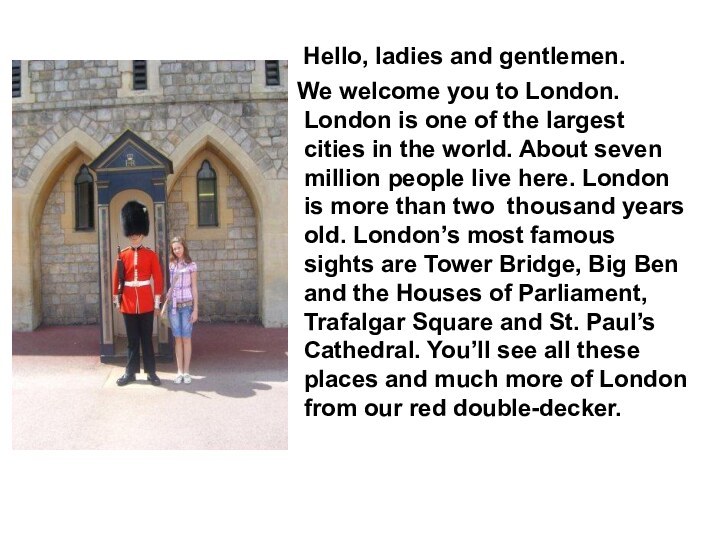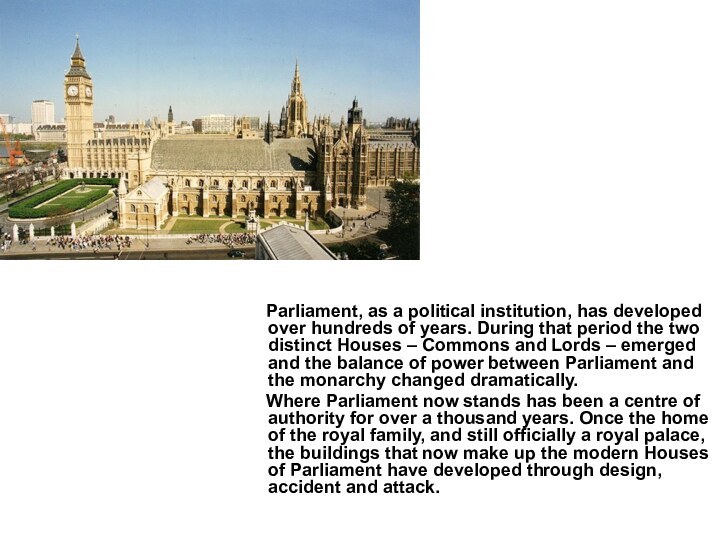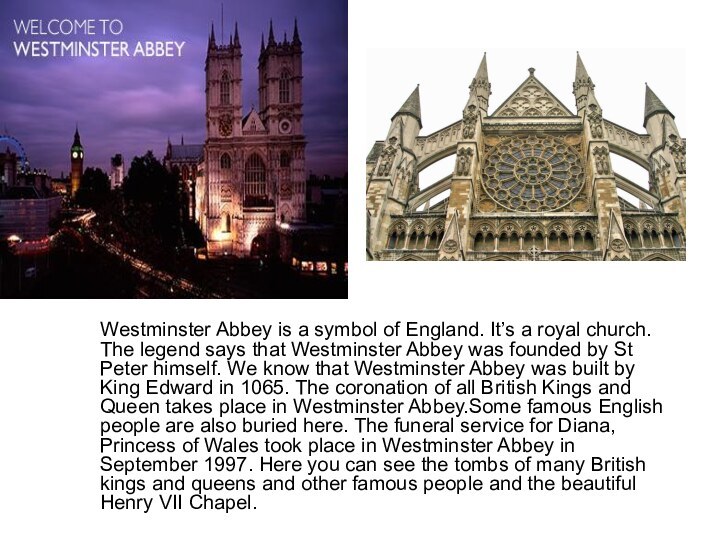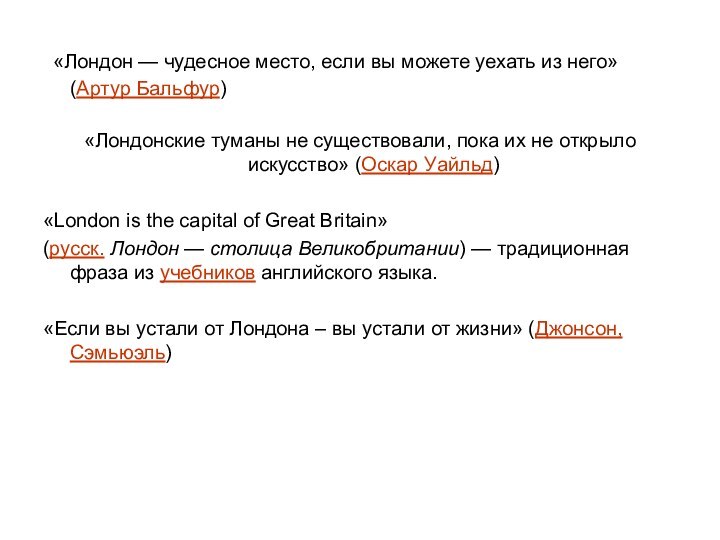- Главная
- Разное
- Бизнес и предпринимательство
- Образование
- Развлечения
- Государство
- Спорт
- Графика
- Культурология
- Еда и кулинария
- Лингвистика
- Религиоведение
- Черчение
- Физкультура
- ИЗО
- Психология
- Социология
- Английский язык
- Астрономия
- Алгебра
- Биология
- География
- Геометрия
- Детские презентации
- Информатика
- История
- Литература
- Маркетинг
- Математика
- Медицина
- Менеджмент
- Музыка
- МХК
- Немецкий язык
- ОБЖ
- Обществознание
- Окружающий мир
- Педагогика
- Русский язык
- Технология
- Физика
- Философия
- Химия
- Шаблоны, картинки для презентаций
- Экология
- Экономика
- Юриспруденция
Что такое findslide.org?
FindSlide.org - это сайт презентаций, докладов, шаблонов в формате PowerPoint.
Обратная связь
Email: Нажмите что бы посмотреть
Презентация на тему London
Содержание
- 2. Hello, ladies and gentlemen.
- 3. The famous clock Big Ben stands near
- 4. Parliament, as a political
- 5. Trafalgar Square is
- 6. On the column in the centre
- 7. Tourists in London always want to visit
- 8. The palace was commissioned by
- 9. Westminster Abbey is a
- 10. Whitehall is
- 11. You can see the
- 12. This is Buckingham Palace – the place
- 13. Madame Tussauds is a famous wax museumMadame
- 14. With its royal, political and literary
- 15. Covent Garden is a
- 16. The Royal Parks of
- 17. Piccadilly Circus is the
- 18. «Лондон — чудесное место, если вы
- 19. Скачать презентацию
- 20. Похожие презентации
Hello, ladies and gentlemen. We welcome you to London. London is one of the largest cities in the world. About seven million people live here. London is more than two thousand years old.



















Слайд 3 The famous clock Big Ben stands near the
Houses of Parliament. The country’s leaders speak in the
Houses of Parliament.The Houses of Parliament stand beside the river Thames. You can also see Big Ben and the Houses of Parliament from Westminster Bridge.Слайд 4 Parliament, as a political institution,
has developed over hundreds of years. During that period
the two distinct Houses – Commons and Lords – emerged and the balance of power between Parliament and the monarchy changed dramatically.Where Parliament now stands has been a centre of authority for over a thousand years. Once the home of the royal family, and still officially a royal palace, the buildings that now make up the modern Houses of Parliament have developed through design, accident and attack.
Слайд 5 Trafalgar Square is a
square in central LondonTrafalgar Square is a square in
central London, EnglandTrafalgar Square is a square in central London, England. With its position in the heart of London, it is a tourist attraction; its trademark is Nelson's ColumnTrafalgar Square is a square in central London, England. With its position in the heart of London, it is a tourist attraction; its trademark is Nelson's Column which stands in the centre and the four lion statues that guard the column. Statues and sculptures are on display in the square, including a fourth plinth displaying changing pieces of contemporary art, and it is a site of political demonstrations.Слайд 6 On the column in the centre there
is a statue of Admiral Nelson who defeated the
French at the Battle of Trafalgar in 1805. To the left of us you can see the National Gallery. It has a fine collection of European paintings.Слайд 7 Tourists in London always want to visit Westminster
and see Big Ben. They want to see the
clock in its tower and to hear the bells. Big Ben is one of the most famous clocks in the world. Big Ben is really a bell. You hear it every hour. It is a big bell. It weighs 13,720 kilograms.It has a deep tone and you can hear it on the radio: “This is the BBC. The time is six o’clock.” And then you hear the deep boom of Big Ben six times.
Слайд 8 The palace was commissioned by Henry
VIIIThe palace was commissioned by Henry VIII, on the
site of a former leperThe palace was commissioned by Henry VIII, on the site of a former leper hospitalThe palace was commissioned by Henry VIII, on the site of a former leper hospital dedicated to Saint James the LessThe palace was commissioned by Henry VIII, on the site of a former leper hospital dedicated to Saint James the Less] (from whom the Palace and its nearby Park take their names); the hospital was disbanded in 1532.The new palace, secondary in interest to Henry's Whitehall PalaceThe palace was commissioned by Henry VIII, on the site of a former leper hospital dedicated to Saint James the Less] (from whom the Palace and its nearby Park take their names); the hospital was disbanded in 1532.The new palace, secondary in interest to Henry's Whitehall Palace, was constructed in the red-brick Tudor styleThe palace was commissioned by Henry VIII, on the site of a former leper hospital dedicated to Saint James the Less] (from whom the Palace and its nearby Park take their names); the hospital was disbanded in 1532.The new palace, secondary in interest to Henry's Whitehall Palace, was constructed in the red-brick Tudor style around four courtyards: its gatehouse survives on the north side, flanked by polygonal turrets. It became the principal residence of the monarch in London in 1698, during the reign of William III and Mary IIThe palace was commissioned by Henry VIII, on the site of a former leper hospital dedicated to Saint James the Less] (from whom the Palace and its nearby Park take their names); the hospital was disbanded in 1532.The new palace, secondary in interest to Henry's Whitehall Palace, was constructed in the red-brick Tudor style around four courtyards: its gatehouse survives on the north side, flanked by polygonal turrets. It became the principal residence of the monarch in London in 1698, during the reign of William III and Mary II when Whitehall PalaceThe palace was commissioned by Henry VIII, on the site of a former leper hospital dedicated to Saint James the Less] (from whom the Palace and its nearby Park take their names); the hospital was disbanded in 1532.The new palace, secondary in interest to Henry's Whitehall Palace, was constructed in the red-brick Tudor style around four courtyards: its gatehouse survives on the north side, flanked by polygonal turrets. It became the principal residence of the monarch in London in 1698, during the reign of William III and Mary II when Whitehall Palace was destroyed by fire, and became the administrative centre of the monarchy (a role it still retains). Mary IThe palace was commissioned by Henry VIII, on the site of a former leper hospital dedicated to Saint James the Less] (from whom the Palace and its nearby Park take their names); the hospital was disbanded in 1532.The new palace, secondary in interest to Henry's Whitehall Palace, was constructed in the red-brick Tudor style around four courtyards: its gatehouse survives on the north side, flanked by polygonal turrets. It became the principal residence of the monarch in London in 1698, during the reign of William III and Mary II when Whitehall Palace was destroyed by fire, and became the administrative centre of the monarchy (a role it still retains). Mary I died there, with her heart and bowels being buried in the palace's Chapel RoyalThe palace was commissioned by Henry VIII, on the site of a former leper hospital dedicated to Saint James the Less] (from whom the Palace and its nearby Park take their names); the hospital was disbanded in 1532.The new palace, secondary in interest to Henry's Whitehall Palace, was constructed in the red-brick Tudor style around four courtyards: its gatehouse survives on the north side, flanked by polygonal turrets. It became the principal residence of the monarch in London in 1698, during the reign of William III and Mary II when Whitehall Palace was destroyed by fire, and became the administrative centre of the monarchy (a role it still retains). Mary I died there, with her heart and bowels being buried in the palace's Chapel Royal. Elizabeth I was said to have spent the night there, whilst waiting for the Spanish Armada to sail up the channel. Charles IThe palace was commissioned by Henry VIII, on the site of a former leper hospital dedicated to Saint James the Less] (from whom the Palace and its nearby Park take their names); the hospital was disbanded in 1532.The new palace, secondary in interest to Henry's Whitehall Palace, was constructed in the red-brick Tudor style around four courtyards: its gatehouse survives on the north side, flanked by polygonal turrets. It became the principal residence of the monarch in London in 1698, during the reign of William III and Mary II when Whitehall Palace was destroyed by fire, and became the administrative centre of the monarchy (a role it still retains). Mary I died there, with her heart and bowels being buried in the palace's Chapel Royal. Elizabeth I was said to have spent the night there, whilst waiting for the Spanish Armada to sail up the channel. Charles I slept rather less soundly -- as it was his final bed before his execution. Oliver Cromwell then took it over, and turned it into a barracks during the English CommonwealthThe palace was commissioned by Henry VIII, on the site of a former leper hospital dedicated to Saint James the Less] (from whom the Palace and its nearby Park take their names); the hospital was disbanded in 1532.The new palace, secondary in interest to Henry's Whitehall Palace, was constructed in the red-brick Tudor style around four courtyards: its gatehouse survives on the north side, flanked by polygonal turrets. It became the principal residence of the monarch in London in 1698, during the reign of William III and Mary II when Whitehall Palace was destroyed by fire, and became the administrative centre of the monarchy (a role it still retains). Mary I died there, with her heart and bowels being buried in the palace's Chapel Royal. Elizabeth I was said to have spent the night there, whilst waiting for the Spanish Armada to sail up the channel. Charles I slept rather less soundly -- as it was his final bed before his execution. Oliver Cromwell then took it over, and turned it into a barracks during the English Commonwealth period. It was then restored by Charles II (Charles I's son), who also laid out St. James's Park.Слайд 9 Westminster Abbey is a symbol
of England. It’s a royal church. The legend says
that Westminster Abbey was founded by St Peter himself. We know that Westminster Abbey was built by King Edward in 1065. The coronation of all British Kings and Queen takes place in Westminster Abbey.Some famous English people are also buried here. The funeral service for Diana, Princess of Wales took place in Westminster Abbey in September 1997. Here you can see the tombs of many British kings and queens and other famous people and the beautiful Henry VII Chapel.
Слайд 10
Whitehall is
a road in Westminster is a road in Westminster
in London is a road in Westminster in London, England is a road in Westminster in London, England. It is the main artery running north from Parliament Square is a road in Westminster in London, England. It is the main artery running north from Parliament Square, towards traditional Charing Cross is a road in Westminster in London, England. It is the main artery running north from Parliament Square, towards traditional Charing Cross, now at the southern end of Trafalgar Square is a road in Westminster in London, England. It is the main artery running north from Parliament Square, towards traditional Charing Cross, now at the southern end of Trafalgar Square and marked by the statue of Charles I is a road in Westminster in London, England. It is the main artery running north from Parliament Square, towards traditional Charing Cross, now at the southern end of Trafalgar Square and marked by the statue of Charles I, which is often regarded as the heart of London. Recognised as centre of HM Government, the road is lined with government departments/ministries; "Whitehall" is therefore also frequently used as a metonym for governmental administration, as well as being a geographic name for the surrounding district.The name is taken from the vast Palace of Whitehall The name is taken from the vast Palace of Whitehall that used to occupy the area but which was largely destroyed by fire in 1698. Whitehall was originally a wide road that ran up to the front of the palace. Trafalgar Square was built at its northern extremity in the early 19th century. The southernmost part by Parliament Square is Parliament Street, but there is no longer any obvious distinction between the two on the ground. Combined, the streets cover a total distance of about 0.6 mile (1 km).
Слайд 11 You can see the Tower
of London from the river Thames. The Tower is
very old. It has a long and cruel history. It’s not just one building. The tall building is the White Tower, the oldest part of the Tower of London . The Bloody Tower is near the river. You do not see blood there today. But the Bloody Tower has a history of blood – the blood of men, women and even children.Now the King and the Queen of Britain do not live in the Tower. When the Queen is in London, she stays in Buckingham Palace.
Слайд 12 This is Buckingham Palace – the place where
British kings and queens live when they are in
London.Important visitors often go to the palace. They meet Queen Elizabeth and the royal family inside the palace.
A lot of tourists go to Buckingham Palace.
They stand outside and see the Changing of the Guard. It happens every day at 11.30 a.m.
Слайд 13 Madame Tussauds is a famous wax museumMadame Tussauds
is a famous wax museum in LondonMadame Tussauds is
a famous wax museum in London with branches in a number of major cities. It was set up by waxMadame Tussauds is a famous wax museum in London with branches in a number of major cities. It was set up by wax sculptorMadame Tussauds is a famous wax museum in London with branches in a number of major cities. It was set up by wax sculptor Marie Tussaud.Слайд 14 With its royal, political and literary associations,
St James's Park is at the very heart of
London and covers 23 hectares (58 acres). With a lake harbouring ducks, geese and pelicans. St James's is also home to the Mall, the setting for many ceremonial parades and events of national celebration.Слайд 15 Covent Garden is a district
in London is a district in London, England is
a district in London, England, located on the easternmost parts of the City of Westminster is a district in London, England, located on the easternmost parts of the City of Westminster and the southwest corner of the London Borough of Camden is a district in London, England, located on the easternmost parts of the City of Westminster and the southwest corner of the London Borough of Camden. The area is dominated by shopping, street performers and entertainment facilities and contains an entrance to the Royal Opera House is a district in London, England, located on the easternmost parts of the City of Westminster and the southwest corner of the London Borough of Camden. The area is dominated by shopping, street performers and entertainment facilities and contains an entrance to the Royal Opera House Covent Garden, which is also widely known simply as "Covent Garden", and the bustling Seven Dials area.The area is bounded by High Holborn The area is bounded by High Holborn to the north, Kingsway The area is bounded by High Holborn to the north, Kingsway to the east, the Strand The area is bounded by High Holborn to the north, Kingsway to the east, the Strand to the south and Charing Cross Road The area is bounded by High Holborn to the north, Kingsway to the east, the Strand to the south and Charing Cross Road to the west. Covent Garden Piazza is located in the geographical centre of the area and was the site of a flower, fruit and vegetable market from the 1500s until 1974, when the wholesale market relocated to New Covent Garden Market The area is bounded by High Holborn to the north, Kingsway to the east, the Strand to the south and Charing Cross Road to the west. Covent Garden Piazza is located in the geographical centre of the area and was the site of a flower, fruit and vegetable market from the 1500s until 1974, when the wholesale market relocated to New Covent Garden Market in Nine Elms The area is bounded by High Holborn to the north, Kingsway to the east, the Strand to the south and Charing Cross Road to the west. Covent Garden Piazza is located in the geographical centre of the area and was the site of a flower, fruit and vegetable market from the 1500s until 1974, when the wholesale market relocated to New Covent Garden Market in Nine Elms. Nearby areas include Soho The area is bounded by High Holborn to the north, Kingsway to the east, the Strand to the south and Charing Cross Road to the west. Covent Garden Piazza is located in the geographical centre of the area and was the site of a flower, fruit and vegetable market from the 1500s until 1974, when the wholesale market relocated to New Covent Garden Market in Nine Elms. Nearby areas include Soho, St James's The area is bounded by High Holborn to the north, Kingsway to the east, the Strand to the south and Charing Cross Road to the west. Covent Garden Piazza is located in the geographical centre of the area and was the site of a flower, fruit and vegetable market from the 1500s until 1974, when the wholesale market relocated to New Covent Garden Market in Nine Elms. Nearby areas include Soho, St James's, Bloomsbury The area is bounded by High Holborn to the north, Kingsway to the east, the Strand to the south and Charing Cross Road to the west. Covent Garden Piazza is located in the geographical centre of the area and was the site of a flower, fruit and vegetable market from the 1500s until 1974, when the wholesale market relocated to New Covent Garden Market in Nine Elms. Nearby areas include Soho, St James's, Bloomsbury and Holborn.
Слайд 16 The Royal Parks of LondonThe
Royal Parks of London are lands originally owned by
the monarchy of EnglandThe Royal Parks of London are lands originally owned by the monarchy of England or the United Kingdom for the recreation (mostly hunting) of the royal family. They are part of the hereditary possessions of the Crown.The public does not have any legal right to use the Parks, as public access depends on the grace and favour of the Crown, although there may be public rights of way across the land. The Royal Parks Agency manages the Royal Parks under powers derived from s22 Crown Lands Act 1851. As part of its statutory management function the Agency permits the public to use the Parks for recreational purposes, subject to regulations issued under the Parks Regulation Acts 1872–1926 which are considered necessary to secure proper management, preserve order and prevent abuse within the Parks. The current regulations are the Royal Parks and Other Open Spaces Regulations 1997
With increasing urbanisation of London, some of these were preserved as freely accessible open space and became public parks With increasing urbanisation of London, some of these were preserved as freely accessible open space and became public parks. There are today eight parks formally described by this name and they cover around 5,500 acres With increasing urbanisation of London, some of these were preserved as freely accessible open space and became public parks. There are today eight parks formally described by this name and they cover around 5,500 acres (22 km2 With increasing urbanisation of London, some of these were preserved as freely accessible open space and became public parks. There are today eight parks formally described by this name and they cover around 5,500 acres (22 km2) of land in Greater London.
Слайд 17 Piccadilly Circus is the meeting
point of six streets.
We’ve just
passed Piccadilly Circus and now we are making our way to Buckingham Palace. Look right. We are passing Hyde Park. In the park anyone can stand up and say what they want.It’s a very democratic park.
Слайд 18 «Лондон — чудесное место, если вы можете
уехать из него» (Артур Бальфур)
«Лондонские туманы не существовали,
пока их не открыло искусство» (Оскар Уайльд) «London is the capital of Great Britain»
(русск. Лондон — столица Великобритании) — традиционная фраза из учебников английского языка.
«Если вы устали от Лондона – вы устали от жизни» (Джонсон, Сэмьюэль)





























